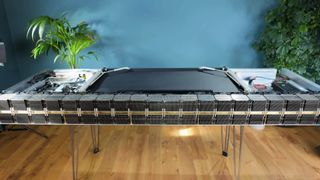Invisible PC projects are ten a penny but this one is so good, I want all my rigs to be like this
As with all great ideas, there are a few hiccups along the way, but the result is well worth it all.
My work and gaming desk is pretty big, but it's also pretty full of monitors and multiple PCs. I could go down the small form factor (SFF) route and free up a lot of space, but that's pretty costly and limits what hardware I can use. It'd be perfect if I could have a magic wand that could hide it all when I don't want it and then bring it out when needed. Or I could just have a go at the same project that one ingenious DIYer has done and have everything seamlessly hidden away inside the desk itself.
Just watch the first 30 seconds of the video to see what I mean. When I first watched it, I wasn't sure what the host was going to show us, in terms of exactly where or what was hidden inside the desk. That 'reveal' sequence genuinely surprised me. It's not like the Lian Li DK-04F gaming desk where just PC components are kept inside, it's an entire PC—monitor, keyboard, mouse, mat, everything.
The display looks to be a Corsair Xenon Flex 45WQHD240, a 45-inch OLED gaming monitor. You might be wondering why this was used instead of something like the Alienware 34 AW3423DWF or the Samsung Odyssey OLED G9 G93SC, because if you're spending $2,000 on a monitor for the ultimate invisible gaming PC, you'd want the very best screen.
The problem is that those monitors have pre-curved panels, whereas the builders here (YouTube channel DIY Perks) wanted an ultrawide OLED panel that could be laid flat against a surface. Personally, I think all ultrawide screens need to have a bit of curvature to them but in this case, it'd make hiding it, and keeping the desk relatively slim, a whole lot harder.
As for the rest of the PC hardware, a ubiquitous Core i9 13900K and GeForce RTX 4090 combination is used, with both being water-cooled. I found it a little funny that, despite having such a huge desk volume to play with, the DIYers chose a tiny ASRock Z790 PG-ITX/TB4 motherboard to house the CPU and GPU.
One issue with the Lian Li DK-04F is that it's designed to fit standard-sized PC components, so the desk itself is pretty thick. To keep this build as slim as possible, around 60 mm or so, DIY Perks used two HD Plex 500W power supplies, which are designed to be used in SFF builds.
Then, just to tip the project into the realms of ridiculousness, storage needs were addressed using what looks like an Asustor Flashstor 12 Pro FS6712X and 48TB of NVMe SSDs, in the form of twelve 4TB Crucial P3s. No idea whether the build uses some decent PCIe 4.0 SSDs in the motherboard but I sure hope at least one is being used for the operating system at least.
The biggest gaming news, reviews and hardware deals
Keep up to date with the most important stories and the best deals, as picked by the PC Gamer team.
Perhaps the biggest engineering challenge was how to keep everything cool, despite the main body of the desk being aluminium. As you can see in the video, the desk isn't very deep, so traditional 120 or 140 mm fans on radiators wouldn't fit. So DIY Perks turned to using a massive stack of old server CPU heatsinks, with laptop fans driving air through them.

I suspect that this wasn't a serious idea—or perhaps one that was just tried as a quick experiment—because server heatsinks only work by having extremely loud and high-rpm fans blasting copious amounts of air over them. Laptop fans, on the other hand, are designed to shift no more than, say, 200 W of heat and even then, they don't do a very good job of it—as anyone with a gaming laptop will tell you.
Naturally, that system didn't work at all, so DIY Perks changed it all for a pile of taller server CPU heatsinks (also with a lower fin density than the first ones), plus a bunch of 140 mm Corsair fans.

Best gaming PC: The top pre-built machines.
Best gaming laptop: Great devices for mobile gaming.
Despite being too big to stay inside the desk itself, you can barely see them, as they're mounted at the rear. The final audio test of it all running at, consuming over 800 W of power, proves the design works well as it's almost inaudible.
DIY Perks call the project the Endgame invisible PC. I wouldn't quite go as far as calling it an 'endgame' system (I'd have gone with a Threadripper system, myself) but you can't design the invisible part. The use of the magnetic paperweight to raise the display and peripherals out of the desk is an inspired decision and the whole thing looks absolutely fabulous.
I really want one now but I have neither the money nor skills to do anything as remotely good as this. Ah well, one can dream, yes?

Nick, gaming, and computers all first met in 1981, with the love affair starting on a Sinclair ZX81 in kit form and a book on ZX Basic. He ended up becoming a physics and IT teacher, but by the late 1990s decided it was time to cut his teeth writing for a long defunct UK tech site. He went on to do the same at Madonion, helping to write the help files for 3DMark and PCMark. After a short stint working at Beyond3D.com, Nick joined Futuremark (MadOnion rebranded) full-time, as editor-in-chief for its gaming and hardware section, YouGamers. After the site shutdown, he became an engineering and computing lecturer for many years, but missed the writing bug. Cue four years at TechSpot.com and over 100 long articles on anything and everything. He freely admits to being far too obsessed with GPUs and open world grindy RPGs, but who isn't these days?
Most Popular








